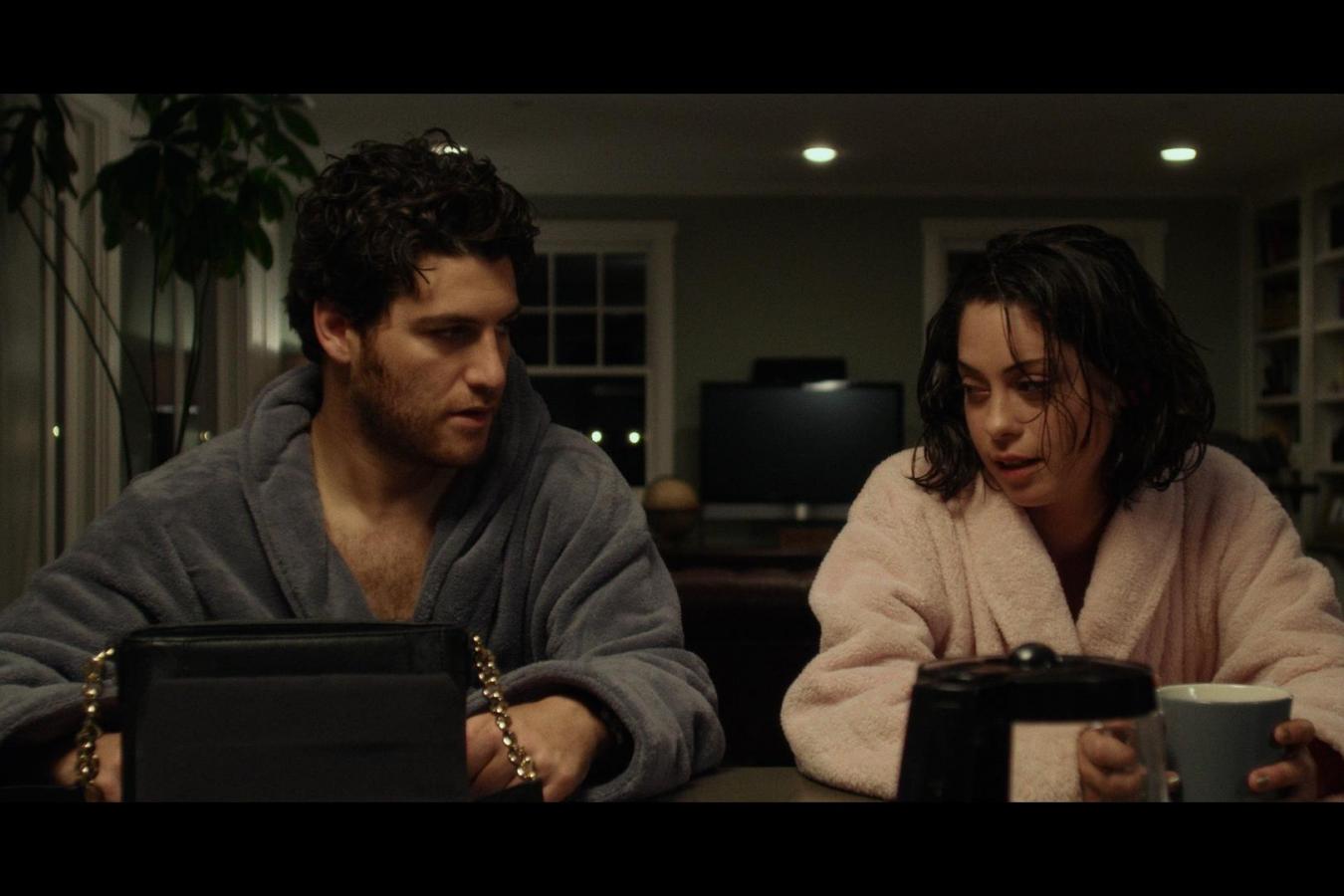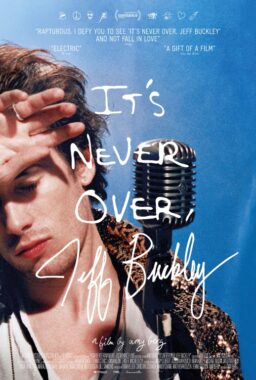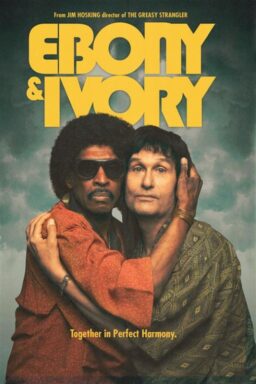The quote “Dying is easy; comedy is hard” has been attributed to numerous comedic talents, from Groucho Marx to 19th century Shakespearean actor Edmund Kean, proving that the sentiment resonates with generations of performers. Comedy is hard, with its reliance on to-the-half-second timing, actors tuned in perfectly to the humor in and underneath any dialogue, and a director who knows how to capture and exploit the comedy in the air. It’s the hardest of all genres to get right. And “Night Owls,” a swift-paced, heartfelt slapstick comedy, makes it look easy. The film has its cake and eats it too in almost every way.
“Night Owls” features only two main characters, and it has the quick loopiness and rat-a-tat conversations of 1930s screwball comedies. Director Charles Hood (who co-wrote the script with Seth Goldsmith) never lets the rhythm fall apart, swinging gracefully from chaos to emotion. It’s old-fashioned filmmaking (that’s a compliment) that doesn’t rely on close-up to close-up shots, or quick cutting. Instead, it uses the chemistry of the two actors, and the strength of the screenplay. “Night Owls” is filled with hilarious physical gags, and scripted dialogue that only sounds spontaneous. The film also has a serious heart, and high personal stakes for the characters. It’s a pleasure to watch a film that is so sure-footed in the “hard” business of comedy, without sacrificing heart or substance.
I was happy to talk recently with Charles Hood about the making of “Night Owls.”
I wanted to talk about the screwball aspect of the film. Classic screwball is not only so fast and so specific, it’s practically a lost art. Could you talk a little bit about how you created the proper mood to make the slapstick in your film—slapstick that also had so much heart in it—come across?
It started with my writing partner Seth Goldsmith and I, talking about the challenges of the script we had written. Because in the first five minutes our main character tries to kill herself. We knew we would never betray that, but at the same time we wanted it to be really funny and get those bigger funny moments, like with the treadmill. It was something we talked about in the writing, my cinematographer and I talked about it, and then I talked about it with the actors while we were shooting. We all talked about never betraying that beginning scene. Seth and I are both huge fans of Preston Sturges; “Palm Beach Story” is one of my favorite movies ever. I love “The Lady Eve,” and of course “Bringing Up Baby.”
You filmed it quickly too, right?
It was about 17 days total.
Did that help with the fast pace of the movie itself?
Yes, there was an urgency. There wasn’t time to do a lot of takes. There weren’t a lot of times where I had to tell the actors to pick up the pace. Their chemistry is so good, and they stayed pretty close to the script. The way we shot it in all those unbroken takes helped too because they could just play off of one another.
Unlike with a lot of films, in your film a cut really means something. It felt like you, and your team, were on the same page.
I’ve known Adrian Correia, my cinematographer, for ten years now. He’s really been a mentor to me. The shot list for “Night Owls” was practically the final draft of the script. We planned out every shot, and stuck about 95% to the shot list. Grant Surmi, the editor, was my best friend in college and so he and I also have a very close bond. We work really fast together. He edited Errol Morris’ movie “Tabloid.” We were all very like-minded.
Could you talk about how you work with another writer? I’ve always been curious about that process.
I work with two different writing partners, actually. I work with one guy during the day, and then I work with Seth at night, because Seth has a day job. Seth and I usually work at Chipotle. Everybody at Chipotle knows us. We sit in the corner with our computers. We’re always in the same room when we write or re-write. Every line goes through both of us. It’s great to have someone call you on your bullshit. Seth is really good on character logic and structure. It’s great to have someone who won’t let you take the easy way out.

I’ve heard people say that they work faster when they work with somebody else. Working by yourself, you can start to second guess yourself or get into dead ends you can’t get out of. But having somebody there means you are accountable to somebody else.
Yes. And working with two different writers also allows me to get double the work done. If I work by myself, I can never work on two things at once. My brain just can’t. So when I work with one guy and then I go to work with the other guy, I have to shut off that part of my brain that was working on the first script. The second guy doesn’t know anything about it so I can’t even talk to him about it. It helps me compartmentalize a little bit.
The film challenges the audience’s preconceptions about the two characters. Any preconceived notions that I had about either of them—and I had very strong ones for about the first 10, 15 minutes—began to fall apart the more they revealed about themselves, and it made me ask myself why I had those preconceived notions.
That’s exactly what we were hoping would happen. We wanted the story to unfold kind of like a mystery. A romantic comedy-slash-mystery. Before “Night Owls,” we had been trying to write a studio comedy, so we got very much into structure, and studying structure. The scripts we wrote were very solid structurally, and we learned a lot doing that. “Night Owls” was unlike anything we had ever done before. A lot of it is just the two of them talking and getting to know one another, so we really had to start from character. We made character profiles. We wrote out lots of stuff about who they were, and what they had in their refrigerators and what did their homes look like? We had never done that before and I think it really helped us find things that they could talk about. It had the element of those “Before Sunrise” movies that were so amazing. Ours has a little more urgency because there’s a ticking clock—well, “Before Sunrise” has a ticking clock too—but in ours there’s a bad guy on the way. [Laughs] The most important thing was to find ways to create conflict between them, and also create enough of a connection. It’s the same thing with any relationship. My wife and I are so similar in a lot of ways and so opposite in many other ways. We wanted to find that connection of WHY they are good together.
Even the coach has some depth. I mean, the man wrote a fantasy novel.
Yeah, we sent Peter Krause the script, and told him we’d love to have him in the part. We met him for dinner. Seth and I, when we wrote it, did not want the coach to be a super-villain. He cares about her. Of course he cares about her. He had a relationship with her for three years. Is he manipulating her? The way I felt about it, and how Peter felt when we talked about it … I’m sure he’s manipulating her, but I think he cares about her too. I don’t think he’s a bad guy.
Once we start to get to know her, preconceived notions about the coach start to shift, too. You realize that she is not the kind of person who would be with a sociopath for that long. He must have some substance because she is very smart too. She’s in love with him.
That was the intention.
Did you rehearse at all?
I know rehearsal works well for a lot of directors but I really like the spontaneity and the magic of the first take. A lot of times, also, the first take is a total disaster, but sometimes it can be something you don’t expect. We did one table-read a week before the shoot, and then when we were setting up lights before we’d shoot a scene, I’d go off into another room with Adam and Rosa to talk it through. I wanted them to save it for when the cameras were rolling especially for their big emotional scenes.

How did you come to cast Adam Pally and Rosa Salazar?
When we finished the script, we gave it to our agent and she asked us to make a list of actors and actresses. Adam was on that list. He was the only person we went to, actually. Our agent gave it to him and within 24 hours, he was on board. It was surreal. Seth and I had been working on the script for two years and overnight it became real. Rosa was not on my radar. Adam recommended her, he had done a few scenes with her in another movie. I was blown away just from her reel, but then when I sat down with her, within five minutes I thought, “Oh God, she has to do this part.”
When you’re on the set, how do you problem-solve?
Everything in filmmaking is problem-solving. That part of your brain is constantly on because there is always something that comes up. My cinematographer is an incredibly important collaborator in that way. There wasn’t quite as much room in the house to shoot in the way we wanted so we had to change some things. The whole trophy room scene was supposed to be in one shot, and then we realized we did not have enough room to lay a dolly track in there.
There’s the scene in the movie where they hug in the hallway and he gets an erection. In the script, that was supposed to be happen in the pool. But we never could get the pool to be heated and we were shooting in March and it was freezing cold. Our AD told us that the actors were only allowed to be in the water for ten minutes at a time. Each time they went in the water for ten minutes, they would have to go inside and warm up for half an hour.
Those are the actual rules?
Those are the actual rules so they don’t get hypothermia. The pool scene was looming for a week. Every day we were thinking about the pool and people would come and try to heat the pool and it never worked. I was living at the house during the shoot and so were Adam and Rosa. So, Adam, Rosa, Seth and I went into Adam’s room, and the four of us talked it out. We came up with: what if they jumped in the pool and then immediately ran inside to get warm and then have that scene in the hallway. Seth and I had to run off and write it. But doing the scene in the hallway ended up working out way better. Because I think the scene in the pool would have been kind of a cliche. We’ve seen it before. But to have them jump in and out of the pool is so much more fun.
That scene was like them going from being kids to being adults in two minutes. One minute they’re playing in the pool and in the next minute they’re having erections and they don’t know what to do.
[Laughs] It was a great problem to have. Shooting a movie always presents you with great problems like that that are a lot of fun to fix.












